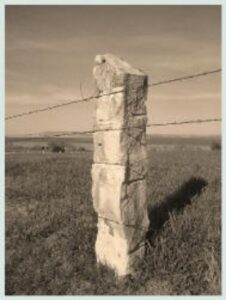The Land of the Post Rock is a distinction given to about 3 million acres in North Central Kansas. In the area, a single bed of rock in the Greenhorn limestone layer was used extensively for stone fence posts during the early days of Kansas settlement.
These posts are an identifying feature of the landscape. And you, too, can enjoy their charm and historical significance at your home or business.
Although historically used to anchor fencing, today, you can use these gorgeous, steadfast fence posts in a variety of applications.
Sturgis Materials, your Kansas City-area natural stone supplier, stocks Kansas Limestone fence posts in our seven-acre stoneyard and building material supply showroom.
These are pieces of American history, rich in texture and character. Many still have the original barbed wire attached through holes bored out by frontiersmen of days past.


Each stone fence post is uniform in thickness, usually between 8” and 12”. They are generally between 5 feet and 6 feet tall, and weigh between 350 to 400 pounds.
Imagine the hard work and ingenuity required of Kansas settlers to remove these large pieces of stone from the ground!
Finding the land destitute of timber, Kansas settlers used the only material at hand to build fences to protect their livestock: a layer of limestone rock close to the ground’s surface.
They found this layer extended for miles with little interruption. When freshly quarried, it was soft enough to shape with tools, but hardened after being exposed to air.
Unfortunately, quarrying rock long enough to make fence posts and other building materials required skill, hard work, and time. Transportation was another major barrier. But having no choice, these determined settlers made do.
They hauled posts to pastures on sleds or using forked tree limbs with crosswise branches to hold several posts. They relied on a team of horses to pull the sled to the post hole.
Settlers buried the heavier end of the post into the prepared holes, which were dug by hand to a depth of up to two feet. They required 320 posts per mile, and corner posts were propped into a perfectly vertical position by leaning other posts against it at a 45-degree angle.
The work was hard, but the results were iconic. Honor these settlers’ efforts with your own Kansas Limestone fence post in your landscape.

Hours:
Monday – Friday: 7:00AM – 4:30PM
Saturday: 8:00AM – 12:00PM